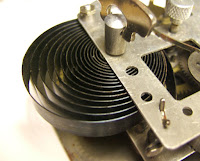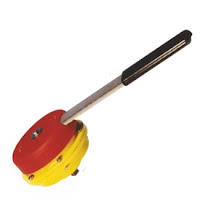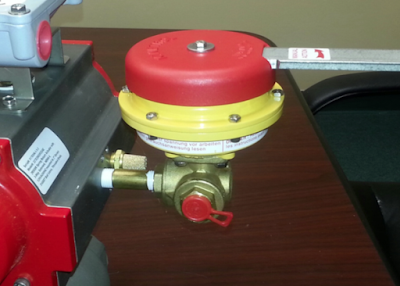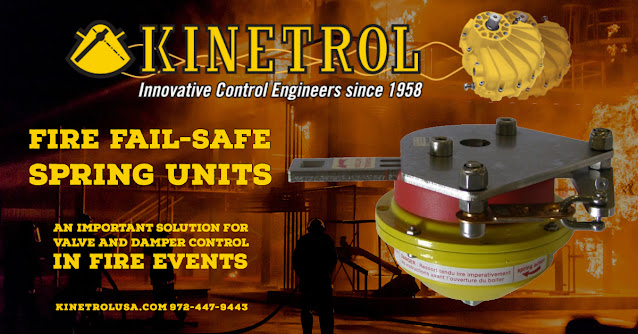The Kinetrol rotary vane design is based upon a single moving part which eliminates additional parts required to convert linear motion to rotary motion. This simple and innovative design provides a highly accurate and extremely reliable actuator for operating valves, drives and dampers, and is perfectly suited for the most demanding process control applications. For more information visit www.kinetrolusa.com or call 972-447-9443.
Kinetrol Fire Fail-Safe Spring Units: An Important Solution for Valve and Damper Control in Fire Events
"Failure Is Not an Option" - Kinetrol Manual and Fire Fail-Safe Spring Units
If you want to operate a valve manually, but maintain the advantage of the fail-safe spring's certainty of position when unattended, check out the Kinetrol's manual and fire fail-safe spring handle. This uniquely designed manual operator offers some compelling benefits in automating valves and provides additional plant safety levels. Spring return (also known as "deadman") handles will help you meet individual plant safety requirements and OSHA requirements for valves that must return to the closed position after an operation. Unlike lever handle or gear operators that will leave the valve in the last state, the spring return deadman device ensures that the valve returns to its original starting position powered by the associated spring handle.
The Advantages of Torsion Springs for Pneumatic Actuators
 |
| Kinetrol uses a torsion spring as the motive force for their actuator spring return. |
Torsion (clock) springs posses a natural tendency to expand, producing a cumulative torque that increases as the spring is wound tighter. Both ends of the torsion spring are attached to other, separate components. When one component rotates around the center point of the spring, the spring will increasingly try to return to the original state. When a torque is applied to a spiral torsion spring, an angular displacement is created between the first and second loading points. The coil then deflects (tightens), and the spring material is placed under stress, which in turn exerts a linear rotational "output" torque.
 |
| An internal view of the clock spring. You'll note similarities with the Kinetrol spring return unit. |
Practically speaking, spiral torsion springs allow for lower torque loss, lower torque stress, and much greater reliability for use in valve and damper actuation.
Advantages of the torsion spring:
- High torque delivery per unit of deflection
- Low cost
- Compact
- Reliable
- Adjustable
Need a Fail-Safe Valve Operator? Use This One.
 |
| Kinetrol manual fail-safe spring unit. |
These spring return units are designed to be put on valves to prevent, or limit, the impact of potentially hazardous accidents resulting from uncontrolled flowing fluid and gasses or spillage.
The Kinetrol manual fail-safe spring unit has a ISO/DIN female drive for direct mounting and ATEX category 2 options for use in hazardous areas. Kinetrol also offers a range of fire fail-safe spring assemblies that can be set to operate valves at pre-configured temperatures.
Because they cannot be left in the wrong position, they are commonly referred to as "deadman handles". Theses devices provide reliable torque delivery for valve reseating and come with completely sealed spring housings that meet IP65 levels, totally protecting the internal spring from the environment, making them ideal for outdoor applications.
20" High Performance Butterfly Valve Closed in Under 1/2 Second!
 |
| Fast closing Kinetrol actuator |
You'll note the valve takes about 11 seconds to open, but only 0.4 seconds to close, using the Kinetrol spring return unit.
Quick closing valves are used in emergency situations to stop the flow of fluids that may contribute to uncontrolled combustion, cause backstream contamination, or allow spillage of hazardous materials.
Innovative Approach to Add Manual Failsafe Handles for Large Quarter-Turn Valves
 |
| Kinetrol manual failsafe unit |
Here's an innovate and effective way to incorporate a manual failsafe unit on large size ball, butterfly, or plug valves.
Retrofit your large valve with a 3-way "L" port ball valve and a manual failsafe spring handle on the large valve actuator's inlet air supply port.
This allows the opening of the valve with the manual failsafe handle. When the handle is released, the valve shuts automatically by venting the air to atmosphere, and allowing the springs in the actuator to close the valve.
Size limitations on the valves are no longer an issue, and this will work on anyone's pneumatic spring return actuator (spring return required, will not work on double acting actuators).
 |
| Manual Override for Larger Valves |

